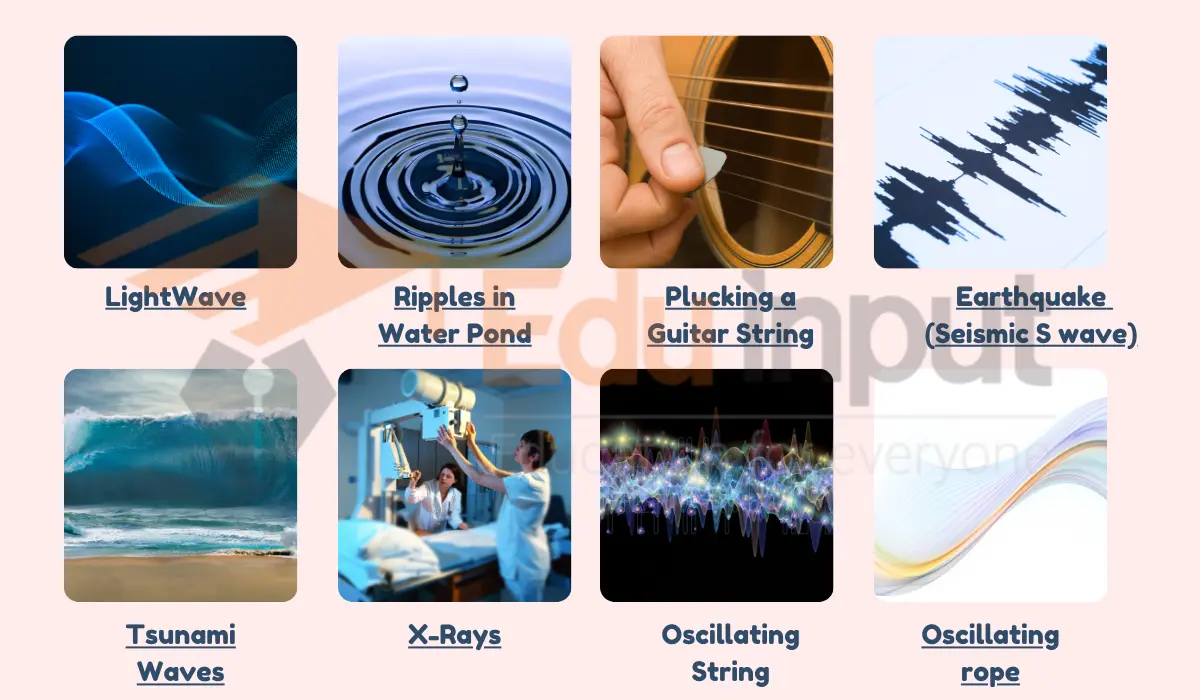Periodic Waves-Transverse Periodic Waves and Longitudinal Periodic Waves
Periodic waves are defined as the waves which are produced due to continuous regular and rhythmic disturbances in the medium are called periodic waves. A good example of a periodic vibrator is an oscillating mass-spring system.
Transverse Periodic Waves
Consider one end of a rope connected to a periodic vibrator. As the mass moves up and down, transverse waves are generated in the rope which is called transverse periodic waves.
These waves consist of crests and troughs.
What is Crest?
The portion of a wave with maximum amplitude above the equilibrium position is called the crest.
What is Trough?
The portion of a wave with a minimum amplitude below the equilibrium position is called a trough.
As the source executes SHM with amplitude A and frequency every point of the rope vibrates with the same amplitude and frequency.
The wave travels towards the right, consisting of troughs and crests. In this way amplitude of the wave is equal to the amplitude of the vibrator.

What is the wavelength of a wave?
The distance between any two consecutive crests or troughs is called wavelength.
It is denoted by λ. In the SI system, it is measured in ‘m’
Speed of Wave
The speed of the wave can be measured by the motion of a crest over a measured distance in a particular time. The speed of a periodic wave can be determined indirectly by its frequency and wavelength.
When a wave progresses in a medium, each point of the medium oscillates periodically with the same frequency and period as the source.

A periodic wave is moving right from the source. The photograph is taken every 1/4 period.
When t=0, the crest started out from the extreme left. The time taken by this crest to move a distance of one wavelength is equal to the one period of oscillation T. Thus the speed V of the crest is given by
V = distance moved /Time interval = λ/t
But
1/t=f
Where f is the frequency of the wave which is the same as the frequency of vibrator V = f λ.
The phase of a wave
The points on the periodic wave which have similar or identical displacements are said to be in phase. The points C and C’ as they move up and down are always in the same state of vibration.

The same is the case with points D and D’.
All particles (C & C’, D&D’) which are in phase have identical displacements and velocities. Thus the points separated from one another through distances of λ, 2 λ, and 3λ….are all in phase with each other.
Similarly the points P, P’, P’’…. are also in phase because each is separated from the next by a distance. There are some points that are exactly out of step.
For example when point C is at maximum upward displacement, then at the same time point D is at maximum downward displacement.
These points are called out of phase by λ /2 Thus any two points separated from one another by λ/2, λ/3…… are out of phase.
Longitudinal Periodic Waves
Consider a coil spring suspended by threads so that it can vibrate horizontally. An oscillating force F is applied at one end of the spring. This force produces compressions and rarefactions in the spring and the period of the longitudinal wave is the same as the period of the oscillating force.
This wave is called a longitudinal periodic wave. The suspension threads start vibrations when a longitudinal periodic wave passes through the spring.
The displacement of the suspension threads measures the displacement of certain parts of the spring due to longitudinal periodic waves. Therefore it is an easy way to graph the displacements of the spring elements from their mean positions.





Leave a Reply